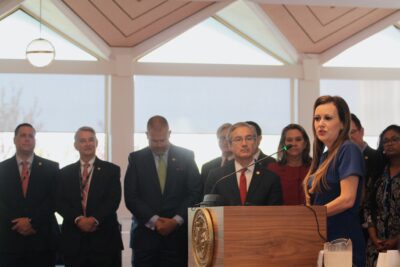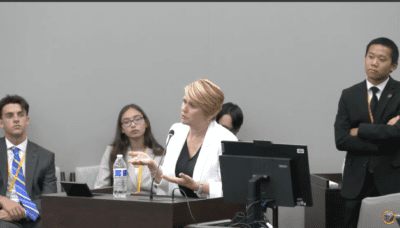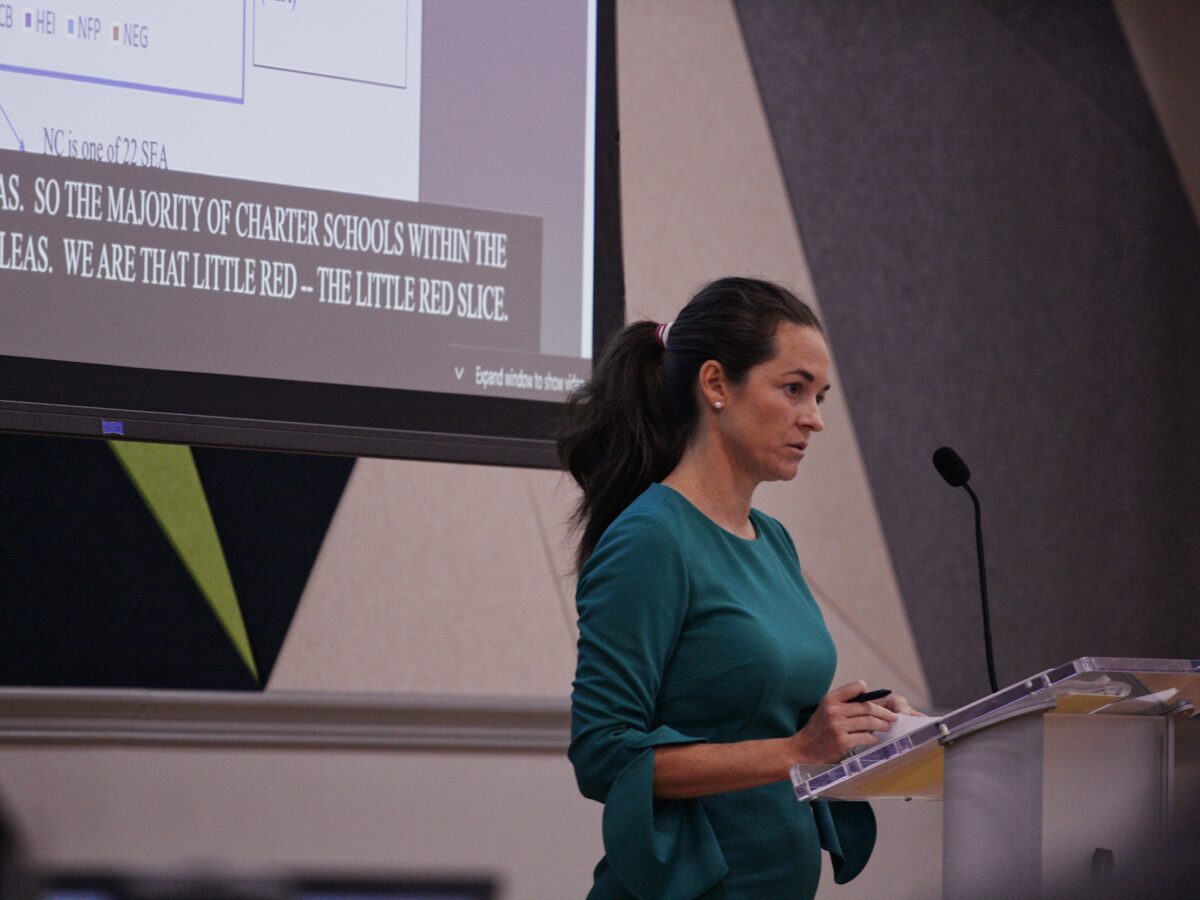
Share this story
- Last year, there were more than 137,500 North Carolina students were enrolled in charter schools, 9% of the state’s public school enrollment.
- Data shows that charter schools and traditional public schools perform similarly, based on school performance grades and school growth. This is the first year DPI has included academic data in its charter schools report.
|
|
From 2019 to 2022, charter school enrollment in North Carolina increased 19% – the fifth highest growth rate in the nation, according to the Department of Public Instruction’s (DPI) annual report to the General Assembly.
Approximately 85% of charter schools had a waitlist last year, per self-reported DPI data, totaling more than 77,000 students. That waitlist number could include duplicate students on multiple waitlists, Ashley Baquero, DPI’s director of the Office of Charter Schools, said at the State Board of Education’s bi-annual planning and work session last month.
“The size of our charter school students is equivalent to a large district,” State Board of Education Chair Eric Davis said.
At the same time, data show that charter schools and traditional public schools perform similarly, based on school performance grades and school growth. This is the first year DPI has included official academic performance data in its charter schools report since the 2018-19 school year.
This long session, the legislature has introduced multiple bills expanding school choice, through private schools and charters, which are public schools with more flexibility. While charter schools demonstrate the choice already available in the public school system, traditional public schools remain the top choice for most of the state’s students.
Sign up for the EdWeekly, a Friday roundup of the most important education news of the week.
Fifty-three of 195 charter schools (27.2%) received a school performance grade of A or B last year, the report says. In comparison, 591 of 2,595 traditional public schools (22.8%) received an A or B.
DPI is currently working to update its school accountability model to include more metrics. Currently, school grades are based on each school’s achievement score, weighted 80%, and on students’ academic growth, weighted 20%.
However, charter schools provide students with stronger learning outcomes in math and English compared to traditional public schools, according to a new national report by Stanford University’s Center for Research on Education Outcomes. The report also found, among other things, that students receiving special education services had significantly weaker growth in both math and reading compared to their peers in traditional public schools.
Nearly 70% of all public schools – including charters – met or exceeded expected annual academic growth last year. Among only charters, nearly 63% met or exceeded growth.
“It’s important, I think, for us to understand that relationship,” Board Vice Chair Alan Duncan said.
Last year, 77 of 195 charter schools (39.4%) received a D or F, compared to 1,097 of 2,595 traditional public schools (42.3%). Baquero said that charter schools have a smaller proportion of continually low-performing schools than traditional public schools due to the fact that those charter schools are often closed.
Since 1998, there have been a total of 87 charter terminations, per the report.
Here’s a look at low-performing schools comparisons, presented at the Board’s June meeting at the Board’s request.
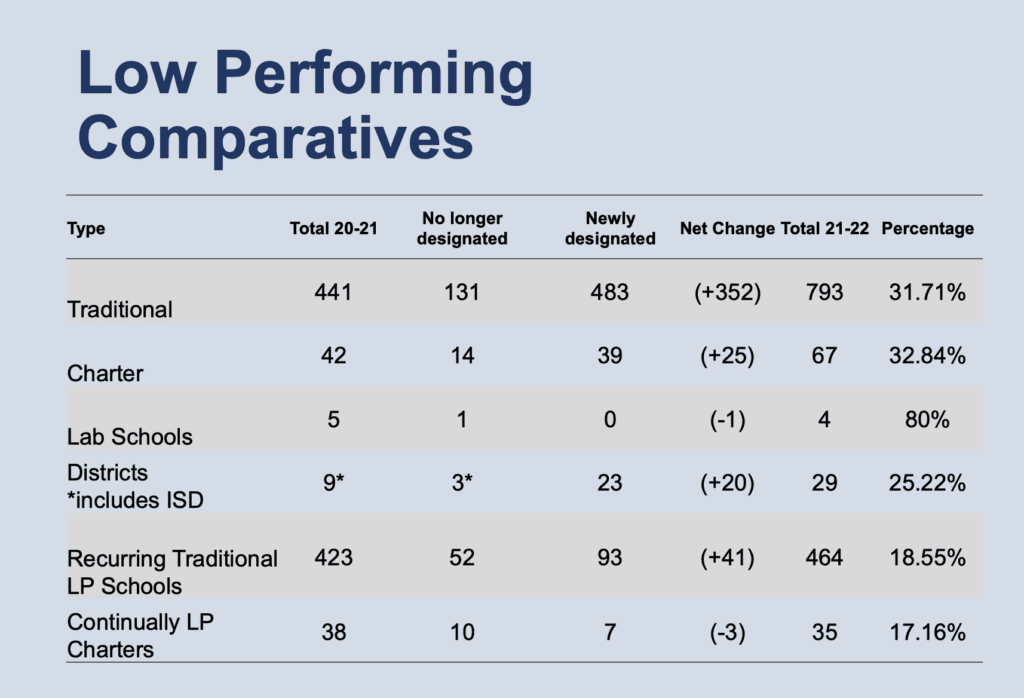
Here’s a further look at 2021-22 Charter School Performance Grades.
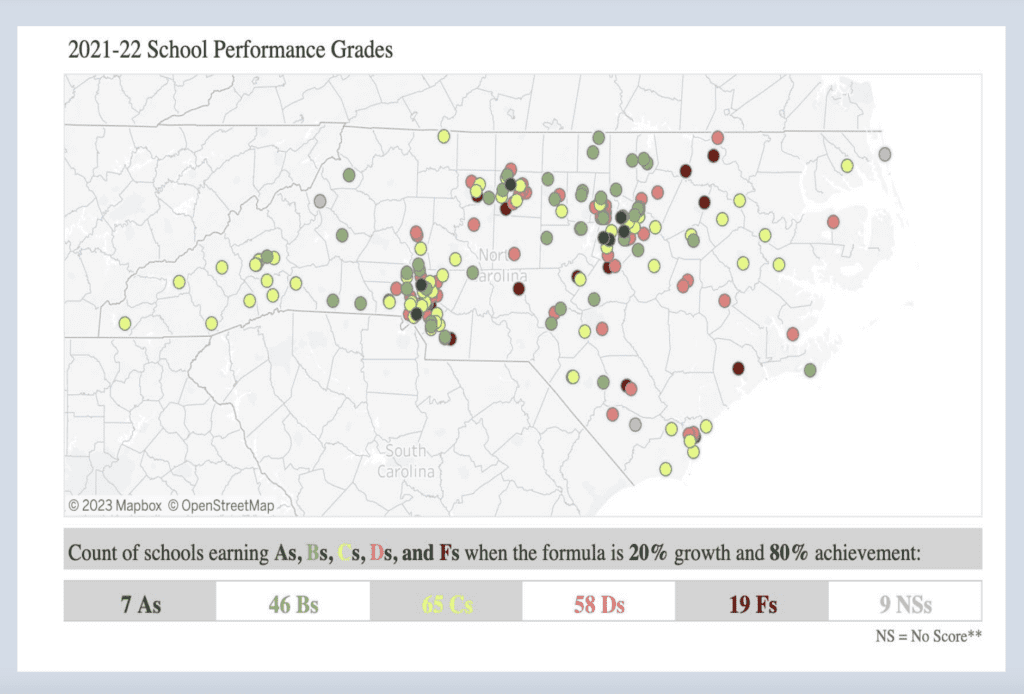
You can view the full presentation on charter schools here, and the General Assembly report here.
History of charter schools in N.C.
In 1996, the N.C. General Assembly passed the Charter School Act, authorizing the establishment of “a system of charter schools to provide opportunities for teachers, parents, pupils, and community members to establish and maintain schools that operate independently of existing schools.”
The intent of this act was primarily to:
- Improve student learning.
- Increase learning opportunities for all students.
- Encourage the use of different and innovative teaching methods.
- Create new professional opportunities for teachers.
- Provide parents and students with expanded choices available in the public school system.
- Hold the schools established accountable for meeting measurable student achievement results.
There are currently 206 charter schools in North Carolina, the report says. Six new charter schools opened this academic year.
State law gives the State Board of Education sole authority of charter school oversight in the state, including the approval and renewal of charters. The Charter Schools Advisory Board assists the State Board by providing recommendations. That advisory board is assisted by the Office of Charter Schools.
The Board has approved 26.26% of charter school applications on average between 1997 to 2022.
During this year’s legislative long session, some Republican lawmakers have attempted to change that system. House Bill 618, which has passed the House, would move authority from the State Board of Education to a new Charter School Review Board.
“The State Board is constitutionally charged with supervising and administering our public school system,” Rep. Julie von Haefen, D-Wake, previously said of the bill. “So, if the Board no longer has the authority to approve or revoke or renew charters, which are public schools, then it’s taking away that supervisory and administrative authority of our public school system and transferring it to a completely different board that was created by our General Assembly.”
In February, another bill was filed that would allow charter schools to offer remote academies, like the ones traditional public schools offered during the pandemic.
Another section of the bill allows the state’s two virtual charter schools to continue their pilot status for another year and increase their enrollment – despite consistently being designated as low-performing schools since they were launched in 2015-16.
Who attends charter schools?
Last year, there were more than 137,500 North Carolina students enrolled in charter schools, 9% of the state’s public school enrollment.
“During the pandemic, there was a significant increase in charter school enrollment and demand,” Baquero said. “This demand continued into 2022.”
Historically, some critics of charter schools have said that charter schools serve less diverse populations of students than traditional public schools.
North Carolina charter schools are only slightly more white than traditional public schools, the report shows — 49% versus 44%.
“You can see that over the years, we’ve seen the (local education agency’s) ethnic and racial data fairly aligned to charter schools,” Baquero said. “The biggest difference we always see is with the Hispanic population.”
From 2019 to 2022, there was a 14.3% increase in charter school enrollment among Black students, she said, and a 23% increase among Hispanic students during the same time period. Currently, 21.1% of public school students are Hispanic, compared to 13.3% of charter school students. Baquero said she anticipates that gap to decrease given pandemic growth.
Here is a look at the 2022 ethnicity and racial data.
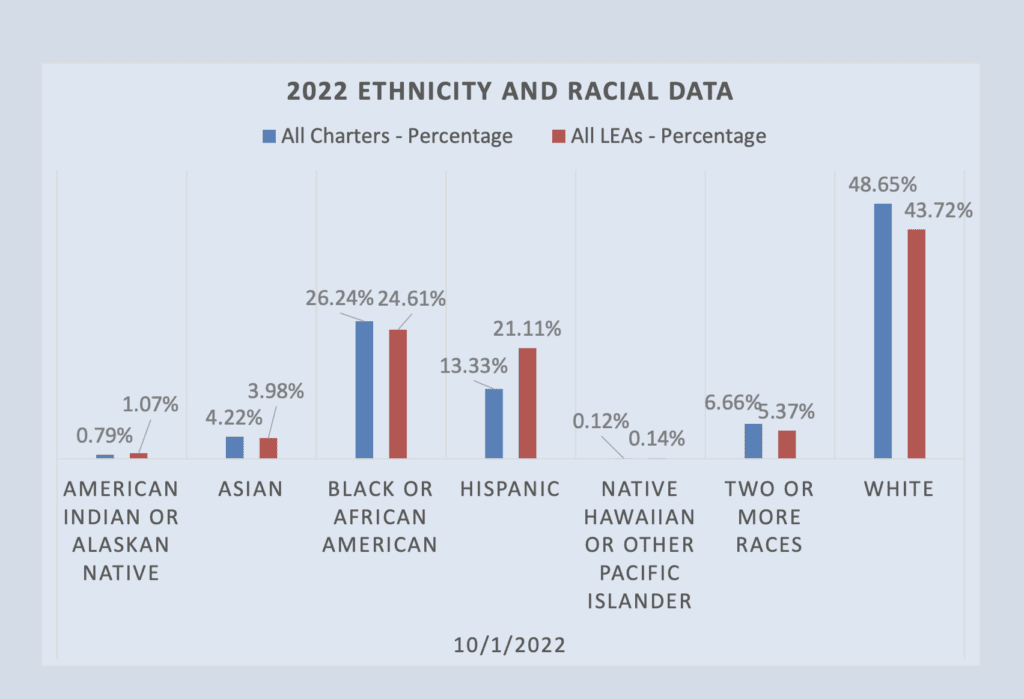
The difference among the enrollment of students with disabilities has remained stable, Baquero said – about a two percentage point difference. Here is a look at that data.
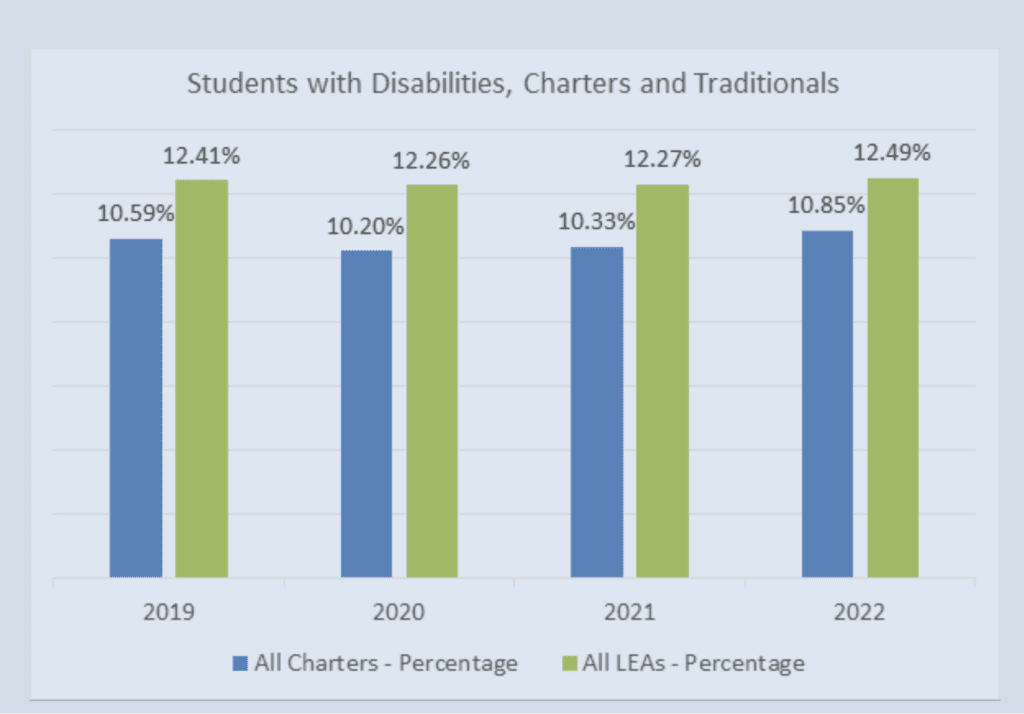
The biggest enrollment gap is among English learner (EL) students, Baquero said, with traditional public schools enrolling twice the amount of English learners than charter schools.
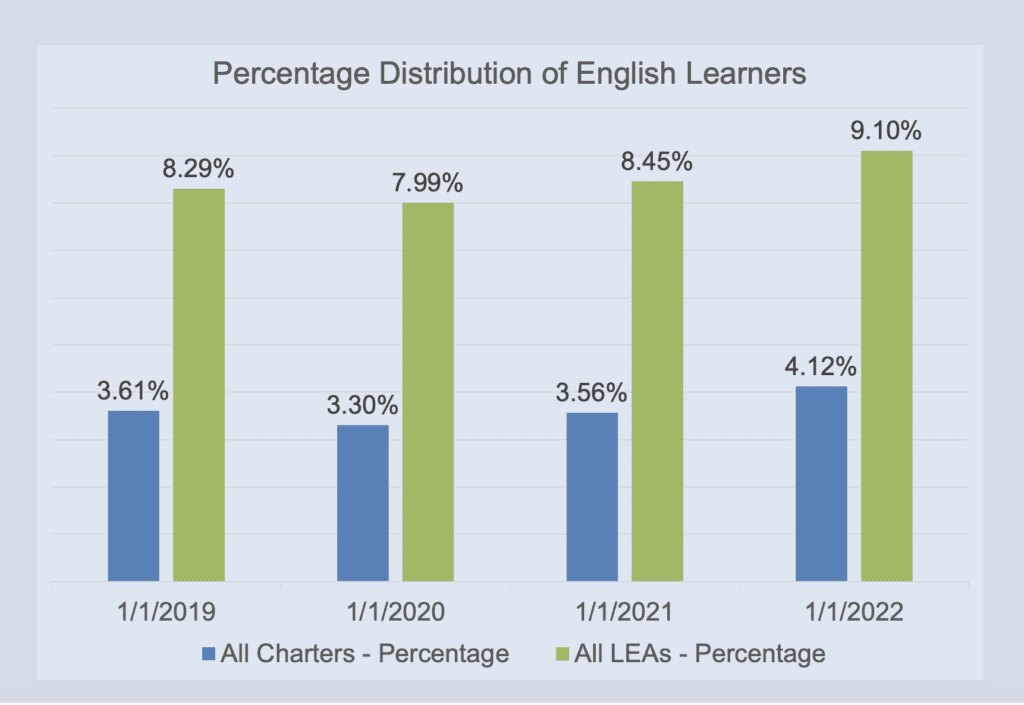
English learner students attending charter schools had stronger growth than their traditional public school peers, according to the report by Stanford University’s Center for Research on Education Outcomes, along with low-income students.
There has been an increase in the number of economically disadvantaged students at charters in the state, Baquero said, but there is still a gap. Last year, 37.26% of all public school students were economically disadvantaged, compared to 30.93% of all charter schools.
Several factors play into this gap, she said – transportation, the National School Lunch Program, federal Medicaid direct certification, and charter reporting.
Charter schools aren’t reqxhools also coordinate carpooling and public transportation for students.
Participation in the National School Lunch Program has also increased to 82 schools.
“We know that transportation and child nutrition are essential components to access,” she said. “Charters are required to ensure that transportation is not a barrier to attendance.”
Board member James Ford asked if DPI has achievement data for these student subgroups.
“I would really like to know how the various student groups are performing in charter schools compared to the local (education agency),” Ford said.
Baquero said her office would work to get that data ready for the Board.
Board member Amy White said DPI needs to dedicate more personnel support for charter schools, pointing to staffing shortages. White announced her resignation from the Board in May and attended her last meeting as a member last week.
“It is a school system in and of itself,” White said of charters. “We need more personnel support dedicated to making sure they get the attention they deserve.”
At the Board’s June meeting last week, Duncan again asked for data separating school academic growth between charter schools and traditional public schools. DPI’s May report showed that 69% of public schools – including charters – met or exceeded growth last year, compared to 63% of charters.
Baquero said she would work with the department that handles school performance data to also bring that data back to the board.
“I do think historically and presently, the charter schools have had a significantly higher percentage score of its charter schools that have failed to meet growth or exceed growth compared to the traditional public schools,” Duncan said. “I think that’s important information for the public.”
Correction: This article has been updated to clarify that this is the first year since 2018-19 that the annual charter schools report included academic performance data for schools, not the first year ever.
Recommended reading
